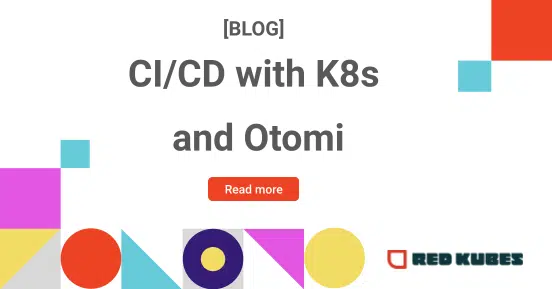






As we look ahead to 2024, the excitement around building and managing container and Kubernetes platforms is shifting to a more realistic outlook. Companies are realizing that these tasks are more complex than originally thought. In the bigger picture, we can expect things to come together and simplify in the coming year. Let's break it down.

Mastering Dockerfile USER: The Key to seamless Kubernetes Deployment

This blog is about the need for a developer platform on top of Clouds or Kubernetes to enable developers to focus on coding and product delivery.

We are announcing the release of Otomi Version 1.0.0, a significant milestone in its maturity. Read this post for all the features.

This blog highlights Kubernetes' flexibility through extensibility, including plugins, Custom Resource Definitions (CRDs), and Custom Controllers. These features enable customizations without altering core code, automate processes, and streamline app-specific tasks.

Read about the role of stateful applications in Kubernetes. Learn more about the differences between stateful and stateless apps and best practices for managing state in Kubernetes apps, including planning, deployment, scaling, monitoring, backup, and recovery.

This blog delves into the core pillars of Kubernetes observability - logs, metrics, and traces - and how they collectively contribute to system insight. We explore essential monitoring tools such as Prometheus, Grafana, and Jaeger, shedding light on their functionalities.

Kubernetes policies are essential for maintaining security and compliance in complex environments. They are sets of rules that govern the behavior of Kubernetes resources, allowing control over actions and access within the cluster.

In this post we discuss various aspects of Kubernetes networking, highlighting its native capabilities and innovative features that make it a powerful solution for microservices architectures. Think service discovery, load balancing, ingress, encryption, certificates, policies and multi cloud networking.

Dive with us into the key considerations for deploying workloads on Kubernetes to ensure smooth operations and optimal performance. We will talk about configuration options for workload deployment, resource allocation, autoscaling, node pools, and artifact attestation.

In this blog we will dive into the evolution of security in Kubernetes, emphasizing the shift from human-centric to machine-centric security measures. It discusses the challenges posed by containerization and cluster computing, and the role of Kubernetes in providing comprehensive security controls.

New Otomi release is live and even more developer capabilities are added.

Kubernetes is an essential tool for managing software containers, but it requires designing and implementing other crucial aspects. This series focuses on those areas, starting with security.

Kubernetes: The ultimate container orchestration platform, chosen by the world. It empowers end users with comprehensive software development and delivery capabilities. Explore its innovative potential now in our 8-piece editorial.

Red Kubes, the creators of Otomi, announces new feature for developers to deploy applications in Kubernetes according to security and compliance policies.

In this article, we’ll explore some of the CI/CD capabilities Otomi has to offer. Note that the setup used in this article is only one of the multiple scenario’s. Otomi supports activating only the required capabilities for your use case in a composable way.

KubeClarity is the latest integrated app to be added to Otomi and can be installed via drag-and-drop to get you running scans in minutes. In this blog, Ryan Dardis, Cloud Native Engineer @ Red Kubes, gives you more on this integration.

In this article, Jehoszafat Zimnowoda, Engineering Manager @ Red Kubes, explains some of the design decisions his team has made for implementing a zero-trust network architecture for Kubernetes.

In this blog post, we’ll explain why you would need developer self-service and how you can get started.

In this blog post we’ll zoom in into a couple of best practices when using Kubernetes in production, and show how these best practices are supported by Otomi.

In a series of 3 posts , we’ll take a look at how Kubernetes fits into the broader technology landscape, and how an enterprise container platform is crucial for digital transformation and the adoption of cloud-native.

In a series of 3 posts , we’ll take a look at how Kubernetes fits into the broader technology landscape, and how an enterprise container platform is crucial for digital transformation and the adoption of cloud-native.

In a series of 3 posts , we’ll take a look at how Kubernetes fits into the broader technology landscape, and how an enterprise container platform is crucial for digital transformation and the adoption of cloud-native.

To implement SRE successfully, there needs to be a correct culture, a collaboration between development and operations (and security), skilled people and of course a good technical architecture. This is where Otomi comes in.

University Professor José van Dijck argues in “De correspondent” today that it is necessary to reduce dependence on big technology companies and develop alternatives with public money.

Getting started with a container platform is a daunting task, and there are many options to choose from, from do-it-yourself (DIY) to fully managed services. Let’s look at the DIY Kubernetes-based platform building approach.

This is our story about building a multi-tenant Kubernetes environment that facilitates various DevOps teams (tenants) with their own Kubernetes namespace and private container registry.

How can you speed up the adoption of Kubernetes? The answer: An internal Kubernetes-based developer platform. Read this blog to learn how

In this post, we’ll explore Kubernetes security risks and challenges you’re likely to encounter, especially in production and at scale, and provide 10 best practices and practical recommendations to help you secure cloud-native infrastructure and applications.

Unfortunately, things aren’t as simple when starting with a container platform. Kubernetes is only one part of a much more complicated infrastructure puzzle, integrating additional software to create an enterprise-grade platform.

This is a story behind the trenches of writing Rego policies and how to unravel the cumbersome process of working with Gatekeeper vs Conftest for validating Kubernetes resources.

You can now use your favorite identity provider to provide SSO and Role-Based Access to Otomi Console, Otomi Apps, and public exposed services.

Improve Kubernetes security by preventing human error and misconfiguration with Otomi Container Platform Container orchestration with Kubernetes is hard enough and securing container and Kubernetes environments brought this to a whole new level of complexity.
 New Feature for developers to deploy secure and compliant applications
New Feature for developers to deploy secure and compliant applicationsRed Kubes, the creators of Otomi, announces new feature for developers to deploy applications in Kubernetes according to security and compliance policies.
 Zero trust networking in Kubernetes
Zero trust networking in KubernetesIn this article, Jehoszafat Zimnowoda, Engineering Manager @ Red Kubes, explains some of the design decisions his team has made for implementing a zero-trust network architecture for Kubernetes.
 10 Kubernetes Security Risks & Best Practices
10 Kubernetes Security Risks & Best PracticesIn this post, we’ll explore Kubernetes security risks and challenges you’re likely to encounter, especially in production and at scale, and provide 10 best practices and practical recommendations to help you secure cloud-native infrastructure and applications.
 Universal OPA Policies Development
Universal OPA Policies DevelopmentThis is a story behind the trenches of writing Rego policies and how to unravel the cumbersome process of working with Gatekeeper vs Conftest for validating Kubernetes resources.
 How to improve Kubernetes security
How to improve Kubernetes securityImprove Kubernetes security by preventing human error and misconfiguration with Otomi Container Platform Container orchestration with Kubernetes is hard enough and securing container and Kubernetes environments brought this to a whole new level of complexity.
 Otomi 1.0 release
Otomi 1.0 releaseWe are announcing the release of Otomi Version 1.0.0, a significant milestone in its maturity. Read this post for all the features.
 KubeClarity – Cloud-Native Security Scanning
KubeClarity – Cloud-Native Security ScanningKubeClarity is the latest integrated app to be added to Otomi and can be installed via drag-and-drop to get you running scans in minutes. In this blog, Ryan Dardis, Cloud Native Engineer @ Red Kubes, gives you more on this integration.
 DIY platform building vs. Otomi Container Platform
DIY platform building vs. Otomi Container PlatformGetting started with a container platform is a daunting task, and there are many options to choose from, from do-it-yourself (DIY) to fully managed services. Let’s look at the DIY Kubernetes-based platform building approach.
 Harbor, Keycloak, and Istio — A Good Dance Troupe
Harbor, Keycloak, and Istio — A Good Dance TroupeThis is our story about building a multi-tenant Kubernetes environment that facilitates various DevOps teams (tenants) with their own Kubernetes namespace and private container registry.
 CI/CD with Kubernetes and Otomi
CI/CD with Kubernetes and OtomiIn this article, we’ll explore some of the CI/CD capabilities Otomi has to offer. Note that the setup used in this article is only one of the multiple scenario’s. Otomi supports activating only the required capabilities for your use case in a composable way.
 Speed up Kubernetes adoption with an internal developer platform
Speed up Kubernetes adoption with an internal developer platformHow can you speed up the adoption of Kubernetes? The answer: An internal Kubernetes-based developer platform. Read this blog to learn how
 Avoid Technical Debt for Kubernetes platforms
Avoid Technical Debt for Kubernetes platformsUnfortunately, things aren’t as simple when starting with a container platform. Kubernetes is only one part of a much more complicated infrastructure puzzle, integrating additional software to create an enterprise-grade platform.
 Keycloak integrated into Otomi Container Platform
Keycloak integrated into Otomi Container PlatformYou can now use your favorite identity provider to provide SSO and Role-Based Access to Otomi Console, Otomi Apps, and public exposed services.
 Otomi version v.0.22.0 is Live! Check out the new enhancements here!
Otomi version v.0.22.0 is Live! Check out the new enhancements here!New Otomi release is live and even more developer capabilities are added.
 Developer self-service for Kubernetes with Otomi
Developer self-service for Kubernetes with OtomiIn this blog post, we’ll explain why you would need developer self-service and how you can get started.
 Kubernetes best practices
Kubernetes best practicesIn this blog post we’ll zoom in into a couple of best practices when using Kubernetes in production, and show how these best practices are supported by Otomi.
 DIY Kubernetes-based platform building – part 3
DIY Kubernetes-based platform building – part 3In a series of 3 posts , we’ll take a look at how Kubernetes fits into the broader technology landscape, and how an enterprise container platform is crucial for digital transformation and the adoption of cloud-native.
 DIY Kubernetes-based platform building – part 2
DIY Kubernetes-based platform building – part 2In a series of 3 posts , we’ll take a look at how Kubernetes fits into the broader technology landscape, and how an enterprise container platform is crucial for digital transformation and the adoption of cloud-native.
 DIY Kubernetes-based platform building – part 1
DIY Kubernetes-based platform building – part 1In a series of 3 posts , we’ll take a look at how Kubernetes fits into the broader technology landscape, and how an enterprise container platform is crucial for digital transformation and the adoption of cloud-native.
 How Otomi supports SRE when using Kubernetes
How Otomi supports SRE when using KubernetesTo implement SRE successfully, there needs to be a correct culture, a collaboration between development and operations (and security), skilled people and of course a good technical architecture. This is where Otomi comes in.
 Otomi increases autonomy in the education sector
Otomi increases autonomy in the education sectorUniversity Professor José van Dijck argues in “De correspondent” today that it is necessary to reduce dependence on big technology companies and develop alternatives with public money.
Interested in Kubernetes, cloud-native and platforms to scale up your business? Get exclusive tech insights delivered straight to your inbox.